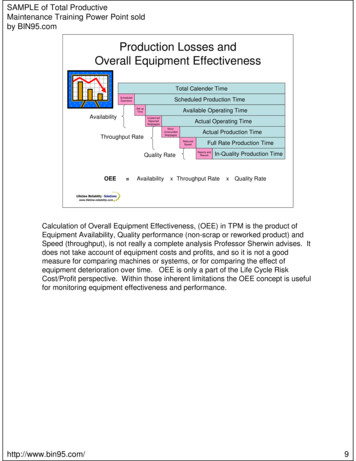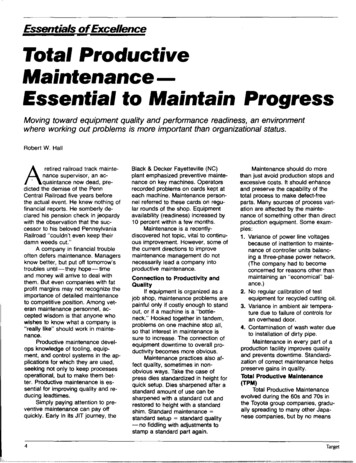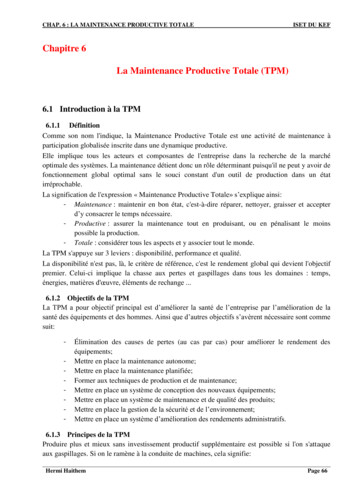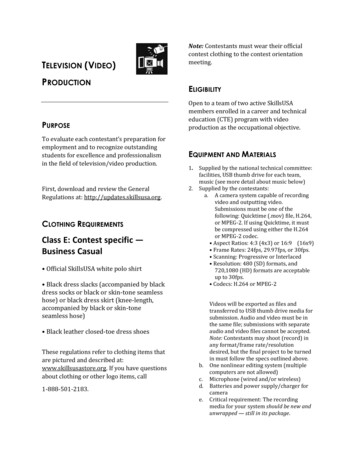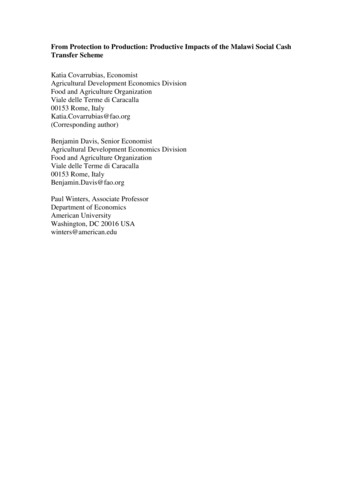
Transcription
From Protection to Production: Productive Impacts of the Malawi Social CashTransfer SchemeKatia Covarrubias, EconomistAgricultural Development Economics DivisionFood and Agriculture OrganizationViale delle Terme di Caracalla00153 Rome, ItalyKatia.Covarrubias@fao.org(Corresponding author)Benjamin Davis, Senior EconomistAgricultural Development Economics DivisionFood and Agriculture OrganizationViale delle Terme di Caracalla00153 Rome, ItalyBenjamin.Davis@fao.orgPaul Winters, Associate ProfessorDepartment of EconomicsAmerican UniversityWashington, DC 20016 USAwinters@american.edu
From Protection to Production: Productive Impacts of the Malawi SocialCash Transfer SchemeAbstractThe Malawi Social Cash Transfer (SCT) scheme is part of a wave of social protectionprogrammes providing cash to poor households in order to reduce poverty and hungerand promote child education and health. This paper looks beyond the protective functionof such programmes, analysing their productive impacts. Taking advantage of anexperimental impact evaluation design, we find the SCT generates agricultural assetinvestments, reduces adult participation in low skilled labour, and limits child labouroutside the home while increasing child involvement in household farm activities. Thepaper dispels the notion that cash support to ultra poor households in Malawi is charityor welfare, and provides evidence of its economic development impacts.Key words: cash transfers, impact evaluation, income generating activities, Malawi1. From Protection to ProductionSocial protection programmes that target poor households and provide cash to thosehouseholds with the objective of increasing their consumption and inducing investment inchild education and health to break the intergenerational transmission of poverty (Fiszbein andSchady 2009, Barrientos and DeJong 2004) are part of an increasingly popular wave ofdevelopment initiatives. However, the primary focus of cash transfer programmes on humancapital accumulation of the young has led to some criticism that these programmes missopportunities to be part of broader rural development programmes designed to alleviatepoverty (Handa and Davis 2006). By providing cash, transfer programmes provide not onlysocial protection but an incentive and opportunity to alter productive activities. Takingadvantage of these opportunities could enhance the value of cash transfer programmes inpoverty alleviation, particularly since cash transfers both increase recipient household incomeand provide a secure source of income.In 2006, the Government of Malawi joined the wave of African nations setting up cashtransfer programmes, initiating its own Social Cash Transfer (SCT) programme as part of apoverty reduction strategy that targeted ultra poor, labour constrained households. The SCTprogramme is an unconditional cash transfer programme designed to reduce poverty, hungerand starvation, and improve school enrolment and attendance and the health and nutrition ofchildren among the poorest 10 per cent of households in Malawi (Miller et al. 2008c). Fundedby the Global Fund through National AIDS Commission and overseen by the Ministry ofGender, Children and Community Development, the programme now reaches 28,000households and is expected to serve 300,000 households with 910,000 children by 2015. At
present, of the approximately 106,000 individual beneficiaries, nearly two thirds are children,and nearly half are orphaned children (UNICEF, 2010).The Malawi SCT value ranges from US 4 per month for a household with one eligiblemember to US 13 per month for households with four or more eligible members. In addition,the programme offers a schooling attendance bonus ranging from US 1.30 per month forprimary school age children to US 2.60 per month for secondary school age children. Givenestimates of average monthly per capita income in the initial target district of US 7.80, this isa significant and reliable income source for beneficiary households. The transfer is likely toinfluence not only household consumption choices, but also production decisions, particularlyif households face market constraints, and production and consumption decisions are notseparable (Singh, Squire and Strauss 1986). Liquidity and credit constraints, in particular, areoften cited as the main factors limiting productive spending and investments and the choice ofincome generating activities in poor rural households (Rosenzweig and Wolpin 1993, Fenwickand Lyne 1999, Lopez and Romano 2000, Barrett et al. 2001, Winter-Nelson and Temu 2005).Cash transfers can help overcome such constraints and allow spending and investment thatalters production and the allocation of resources, including labour.Along with credit constraints, insurance market imperfections also limit the ability tosmooth consumption across time and space. Faced with uncertainty and insurance marketfailure, households may take a variety of actions to hedge against risk including managing riskex ante by diversifying crops or income and through ex post actions to cope with badoutcomes such as selling off productive assets or taking kids out of school to work at home orelsewhere (Dercon 2002). Transfers provide income that is uncorrelated with other sources ofincome potentially altering risk management and coping strategies, and creating an additionalinfluence on production choices.The objective of this paper is to look beyond the social protection function of theMalawian SCT programme and analyse the impact of the programme on productive activities.Three productive areas are considered: (i) investment in assets, particularly agricultural assetsand livestock; (ii) changes in labour allocation primarily as seen through changes in incomegenerating activities; and (iii) alterations in risk coping strategies including the use of childlabour. Previous research has examined cash transfers and productive choices, althoughprimarily in Latin America. For the Mexican Oportunidades programme, Todd et al. (2010)find that the programme increases the value and variety of food consumed from ownproduction and increases land use, livestock ownership and crop spending while Gertler et al.(2006) note that the programme is associated with increased land use and animal ownership aswell as a greater likelihood of operating a microenterprise. Veras Soares et al. (2010) showthat the Paraguayan Tekopora programme increases agricultural expenditures, particularly forextremely poor households. In Nicaragua, however, Maluccio (2010) finds that nearly all thetransfer from the Red de Protección Social is used on consumption and education with littlespending linked to agricultural or non agricultural activities.
In this paper, we seek to add to this body of knowledge by examining the issue in anAfrican context and to look more broadly at the productive choices available to beneficiaryhouseholds and their risk coping behaviour. Malawi presents a particularly interesting casebecause of the widely discussed fertiliser and seed subsidy programme that the country hasused to promote agricultural production. This large-scale programme has been found toincrease national maize production and productivity, contributing to increased foodavailability, higher real wages and wider economic growth and poverty reduction (Dorwardand Chirwa 2011). Of course, the Malawian SCT programme targets extreme poverty, andSCT recipients tend not to benefit directly from agricultural subsidy programmes. Suchextremely poor and vulnerable households are often considered unable to participate inproductive activities, or more broadly, to contribute to rural economic development. It is inthis context, and focusing on this population, that we examine the SCT programme andproductive choices.The remainder of the paper is organised as follows. The next section provides backgroundon the SCT programme, describes the data used for the analysis, and presents descriptivestatistics for that data. Section 3 explains the empirical approach taken to analyse the data.Section 4 presents the results of the analysis while Section 5 explores the heterogeneity ofthose results across a few key household characteristics. The final section draws conclusionsfrom the analysis of the data.2. Data Sources and Programme DescriptionAn important element of the Malawian SCT programme is that it included a rigorousevaluation with assignment of communities to treatment and control groups and pre-treatmentand post-treatments rounds of data collection. That evaluation, which was overseen by a teamof researchers at Boston University’s School of Public health (BU) in collaboration with theCentre for Social Research of the University of Malawi (UM), yielded the data upon whichthis study is based.2.1. Programme design, randomisation and targetingFor the evaluation of the Malawi SCT, a one year pilot of the programme was designed andimplemented in the Mchinji District in central Malawi. Specifically, four control and fourtreatment Village Development Groups (VDCs) forming part of the original programme rollout were randomly selected to be part of the evaluation 1. These eight VDCs correspond to 23villages. Within each village, Community Social Protection Committees (CSPCs) identifiedeligible households according to the national eligibility criteria, and then ranked them in orderto select the bottom 10 per cent for inclusion to the programme. Although the assignment ofthe programme to similar treatment and control groups facilitated the creation of a validcounterfactual, allowing a straightforward analysis to identify impact, the sample design andrandomisation suffer from two weaknesses that contribute to some differences betweentreatment and control households at the baseline.
First, randomisation into treatment and control was at the level of the VDC, with eighttotal units: four treatment and four control. Thus while the overall number of households inthe sample may be sufficient for a rigorous impact evaluation, the number of randomisedVDCs is relatively small, which increases the likelihood of finding differences betweentreatment and control households at baseline.The implication of a small number of randomised units is complicated by a second factor.The Malawi SCT targeting mechanism allows a strong role for community participation.While eligibility rules are consistent across VDCs and communities, since CSPCs are giventhe responsibility of ranking all eligible households in their area, ranking was often donebased on local criteria, leading to variation in how the targeting was finalised2. If a relativelylarge number of communities are randomised into treatment and control, this variation is lesslikely to be an issue as similar sets of rules might be developed across communities. However,in a small sample of communities, variation in these rules may have implications for thecreation of a counterfactual. While it is always important to check whether the randomisationprocess created a reasonable counterfactual, it is particularly important in this case, and we doso in the following section.Baseline data collection began prior to treatment in March 2007, after which the treatmentgroup received the first transfer. Follow up data were collected in September 2007 and againin April 2008, at which point the control households also began receiving transfers since theywere designated as a ‘delayed entry’ group. In total 819 households were originallyinterviewed but 33 treatment and 7 control households (8.1% and 2.7% of the originaltreatment and control sample, respectively) were lost over the two follow up rounds and arenot included in this analysis. The loss of these 40 households was due in part to re-targetingbetween the baseline and first follow up, which found 17 ineligible treatment households, andto the dissolution of 23 households due to deaths (Miller et al. 2011). We ran various tests todetermine whether those households dropped out in any systematic way that would bias ourestimates on the panel sample. Results from those tests indicate that attrition is not a concernand that any minor differences between treatment and control linked to the attrition are likelyto be dealt with using the combined propensity score matching, double difference approach,presented later in the paper3.After excluding the attrition households, linking the three rounds of data yields 365treatment and 386 control households with complete questionnaires over the 2007 to 2008period. These 751 households contain 1,876 children below 18 years of age, among which1,090 belonged to treatment households and 786 to control households. For this study, thechildren are analysed as an entire group, though the impacts for younger versus older agecohorts are also explored since work allocations may change considerably from childhood toadolescence.The survey instrument was designed and implemented by field teams trained by theresearchers at BU and UM. The instrument collected detailed information at the adult andchild level on demographics, anthropometrics, employment, time use, health and healthcare,
disabilities and migration. Child level modules also focused on orphan status and schooling.Household level modules focused on dwelling characteristics, assets, food and non foodexpenditures, income, credit, literacy, shocks, and the access/use of other social safety netsand support programmes. The study was set up as a panel; therefore, the three surveyinstruments are broadly similar. There are important differences, however, in the level ofdetail in sections relevant to the analysis of productive impacts that influence the extent towhich certain topics could be analysed.2.2. Data issues and limitationsOne notable constraint in our analysis stems from the fact that although the data used for thisanalysis constitute a panel following more than 750 households over a period of one year, thesurvey instruments were not identical over time, limiting the household level analysis to acertain extent. The most important differences were observed in the sections on householdlevel income and asset ownership and acquisition.The income module in the survey included changes that affected the comparability of theincome variable estimation over the three rounds of data collection. First, the reference periodchanged from Round 1 to Rounds 2 and 3. In Round 1, households report monthly income,whereas in the follow up, households define the income earned as weekly, monthly or yearly.Though the multiple frequencies provide better information, the change in methodologyimplies incomparable estimates of income levels will be obtained (Azzarri et al. 2010).Secondly, the frequency of income earned, which was not collected in the baseline, wascollected in the follow up rounds allowing for an accurate annualisation using the follow updata but not for the baseline. Further, the list of income sources grew from 17 to 19 items overthe three waves of the survey with the addition of ganyu4 labour and household enterpriseearnings in Round 2. The list of possible sources of income at times did not appear to bemutually exclusive which could lead to erroneous trends if some households classify incomeunder one type of income whereas other households classify the same activity under adifferent source. While these differences in the instrument over time limited the analysis ofincome levels, they do not present obstacles to the analysis of participation in incomeactivities.The asset ownership module experienced a similar evolution to that of income earned,with the number of items growing substantially from the baseline into the follow up. Thefollow up questionnaire did intelligently include questions that allow for ownership at thebaseline to be reconstructed; however, the fact that the information for many items was notactually collected at the baseline indicates that some measurement error may be present in thebacktracked data. Other information could not be backtracked, such as the levels of asset andlivestock ownership at the baseline. The follow up rounds probe for the number of itemsowned, whereas the baseline survey only captured whether or not households owned an item.Furthermore, the collection of land ownership data, a key productive asset, was different overthe three rounds. Whereas at the baseline, the questionnaire asked only whether any land was
owned, the first follow up split the category into Dambo (irrigated) and Upper land. FromRound 2 to Round 3 additional criteria specifying non-fallow land was incorporated. Thesechanges are difficult to reconcile and led to the omission of any analysis of the land variables.Finally, none of the three questionnaires collected detailed information, so we were not able toanalyse the impact of the programme on input use or yields.Even with these issues, the longitudinal dataset did permit indicators of productive impactsto be analysed in several ways, as is discussed in the following sections. Furthermore, thesurvey instrument changes were the same for all households regardless of their status incontrol and treatment so there is no reason to believe that they led to any systematicdifferences between the two groups.2.3. Descriptive statisticsTo explore household level productive impacts we analyse indicators related to livelihoods,income generating capacity and risk coping. Following Zezza et al. (2010) these impacts willbe explored in the context of three main areas: (1) investments in productive assets andlivestock; (2) intra household labour allocation and participation in income generatingactivities; and (3) risk management and mitigation strategies. Specific examples of anticipatedchanges in behaviour following the receipt of a cash transfer include investment in assets, theintensification of self employment activities, the diversification of income sources, andfavouring child schooling over child labour.In order to set the context and establish the validity of the counterfactual for assessingimpact, we describe the characteristics of households and children at the baseline. Table 1reports the descriptive statistics for two sets of variables: (i) those linked to programmeeligibility criteria, and (ii) general household and child level variables, which will be usedlater for the analysis. Descriptive statistics for the household and child level indicatorvariables that we hypothesise are influenced by the programme are presented in Table 2. Inboth cases, differences between control and treatment and tests of significance are presented.The data from the eligibility criteria confirm that virtually all households interviewed inthe control and treatment groups are very poor. Average monthly per capita expenditure isreported to be approximately 1.26 USD, indicating the extremely limited resources availableto these households. Around half of the households consumed one or fewer meals in theprevious day and around half reported owning none or only one durable item. The sampledhouseholds have approximately four members, of which more than two are children under 15years of age. Approximately 57 per cent of the children sampled are either single or doubleorphans. Household heads are notably old at 61 years of age; most are single or female withless than two years of formal schooling and one fifth are chronically ill or disabled. Moreover,households have on average a dependency ratio greater than three, when calculating it usingthe same methodology as Miller et al. (2011)5 and for half of the sample, a dependency ratiocannot be estimated due to a lack of any able bodied adult household members.
In terms of the primary productive variables–assets, labour and risk–households ownvirtually no assets, as can be seen in Table 2. Although households report ownership of smallfarm tools, mostly concentrated in hoes, axes and sickles, ownership of livestock assets islimited to nonexistent. Twelve per cent of households own chickens, 2 per cent own goats andnearly none own pigs or cattle. As such, although 32 per cent of the sample participates in onfarm (crop/livestock) activities, household livelihoods depend on other activities equally ormore. Nearly half are involved in nonfarm enterprises, 39 per cent rely on the receipt ofprivate transfers, and household heads dedicate 7.5 days per month to ganyu labour.Involvement in ganyu work corroborates the level of vulnerability indicated by the assetand expenditures data. Ganyu labour is a low wage informal activity utilised by manyhouseholds as a coping strategy in response to shocks as well as during the hungry season inMalawi. Since the opportunity to perform ganyu is offered by neighbours and friends to needymembers of their social network, it serves as a way for households to share risk with theircommunities and operates as an ‘ex ante social insurance mechanism’ (Dimova et al. 2010).Improvements in household poverty or vulnerability would be related to a reduction in ganyuparticipation. Other risk coping mechanisms, of a more detrimental nature, utilised byhouseholds in the sample include begging (38%) and pulling children out of school to workfor food or money (45%).Children's role in household activities is important, as evidenced by participation rates inboth domestic tasks and income generating activities. Over 60 per cent of children wereinvolved in childcare for household members in the week preceding the survey and close toone fifth were responsible for caring for elderly household members. Further, more than 20per cent were also involved in the household's farm or nonfarm business work. Three quarterswere attending school as well, and the average number of days missed in the previous monthapproached three days.Tables 1 and 2 also present the descriptive statistics by the control and treatmentassignment given in the survey. The results of t-tests on the difference of means across groupsare indicated by the reported P values. Significant differences across the control and treatmentgroups are observed for a number of variables indicating that control households may notsatisfy the criteria of a perfect counterfactual to treatment households. As noted, the reason forthe difference may be related to variation in the community targeting procedures. Acommunity may emphasise certain characteristics in targeting and face tradeoffs between, forexample, supporting those with more children who are extremely poor, or the elderly. Thedifferences between the control and treatment groups appear to be linked to demographics: inparticular, the treatment group has more children and the control, older household heads. Incertain cases, the treatment group appears to be better off than the comparison according tomeasures of school attendance and absenteeism, ownership of sickles, educational attainmentof the household head, and greater participation in nonfarm self employment. By othermeasures, the comparison group is relatively better off, with a lower dependency ratio, a lowerreported frequency of begging, and lower participation in agricultural wage labour.
At the same time, the control and treatment groups are statistically the same across groupsfor certain key variables. These include the variables on poverty and expenditures, asset andlivestock ownership, several of the income activity variables, and nearly all the child labourparticipation variables. Many of these variables coincide with the dependent variables onproductive impacts that will be studied in the next sections, indicating that much of thispaper's analysis will not be confounded by baseline differences.Given the concerns over the counterfactual, we explore what methods might be used tocontrol for pre-existing differences in control and treatment at the baseline. Of course, oneoption is to apply a double difference approach, which we do use and discuss in the nextsection. Alternative approaches include using a series of explanatory variables in the analysisto control for any pre-existing differences and using propensity scores to adjust the treatmentand control groups to create a quasi-experiment where these two groups are similar in baselinecharacteristics. These options are also discussed more fully below. As an initial test of thevalue of these approaches, in Table 2 we explore these options using the baseline data. Sincethis is pre-treatment, the expectation is that there will be limited significant differencesbetween treatment and control in key indicators of impact when using a particular approach.As noted, simple tests of difference show some significant differences, which can be observedfrom the P values in column (v), although the majority of variables are not significantlydifferent. Table 2 then reports baseline tests of differences between treatment and control fortwo additional options: first, when additional explanatory variables are included, and second,using propensity scores6 in a standard matching procedure7. The outcome of these tests aregiven by the P values in columns (vii) and (ix) which indicate that when controlling for otherobservable factors, and when incorporating a matching procedure to correct for baselinedifferences, the pre-existing differences between the treatment and control are nearly entirelyremoved. Details on the use of explanatory variables, on how the propensity scores arecalculated, and how the matching procedure is employed are noted below.3. Assessing Productive Impacts: Analytical MethodsThe results in Table 2 suggest that while using controls helps remove some pre-existingdifferences, propensity score matching performs better in creating a reasonable counterfactualremoving nearly all pre-existing significant differences in key variables. Combined with adouble difference approach this appears to be a reasonable option. To assess the impact of theprogramme on production two approaches are thus used: (i) differences in differences (DD)with conditioning variables, and (ii) differences in differences combined with propensity scorematching (PSM).The DD approach attempts to isolate the effect of treatment, in this case the receipt of theSCT, on the outcome indicator of interest taking advantage of two important characteristics inthe data: (i) that it is a panel data set following the same households over one year, and (ii)that the sample was stratified in order to draw eligible treatment and control groups. By takingthe difference in outcomes for the treatment group before and after receiving the SCT, and
subtracting from that the difference in outcomes for the control group before and after theSCT was disbursed, this methodology is able to control for pre-treatment differences betweenthe two groups, and in particular the time invariant unobservable factors that cannot beaccounted for otherwise. When differences between treatment and control groups are causedby random sampling, the DD estimator with conditioning variables has the advantage ofreducing standard errors thereby allowing for tighter confidence intervals, provided the effectsare unrelated to the treatment and are constant over time (Wooldridge 2002).The treatment effect can be estimated using DD by estimating the equationY i β 0 β 1 SCT i β 2 Round β 3 (Round*SCT i ) BX μ i(1)where Y i is the outcome indicator of interest; SCT i is a dummy equal to 1 if household ireceived the intervention; Round is a time dummy equal to 0 for the baseline and to 1 for thefollow up round; Round*SCT is the interaction between the intervention and time dummiesand, μ i is an error term. To control for household and community characteristics that mayinfluence the outcome of interest beyond the treatment effect alone, we add in BX, a vector ofhousehold characteristics to control for observable differences across households at thebaseline which could have an effect on Y i . We include household head characteristics such asage, gender, marital status, educational attainment and disability; a set of householdcomposition characteristics to control for the number of household members by age cohortand the presence of orphans; as well as variables related to eligibility criteria8. These factorsare not only those for which we observed some differences across treatment and control at thebaseline, but also ones that could have some explanatory role in the estimation of Y i . As forcoefficients, β 0 is a constant term; β 1 controls for the time invariant differences between thetreatment and control; β 2 represents the effect of going from the baseline to the follow-upperiod, and β 3 is the double difference estimator, which captures the treatment effect.Although the DD with conditioning variables should be sufficient to create an unbiasedestimate of impact in a randomised setting when the treatment and counterfactual are similar,we also used the PSM approach given the previously noted concerns about the counterfactual.PSM uses observable characteristics to match treatment households with similar, eligible nonbeneficiary households in the sample. From the sample of households, a maximum likelihoodestimation (probit or logit) is run to estimate programme participation. The regressionestimates are used to calculate propensity scores of programme eligibility, which are then usedto match the treatment households to the non treated households. Observations outside thearea of common support—that is, the overlap of propensity scores between treatment andcontrol—are excluded in this process since they do not represent a reasonable counterfactual.The approach is sometimes referred to as quasi-experimental since the matching procedurecreates treatment and control groups that are alike in all ways except for in receiving thetreatment. More details on matching approach are provided in the Appendix.
For the PSM approach, a nearest five neighbours matching procedure is used in whichtreatment households are matched with the control households having the five c
of researchers at Boston University's School of Public health (BU) in collaboration with the Centre for Social Research of the University of Malawi (UM), yielded the data upon which this study is based. 2.1. Programme design, randomisation and targeting . For the evaluation of the Malawi SCT, a one year pilot of the programme was designed and

